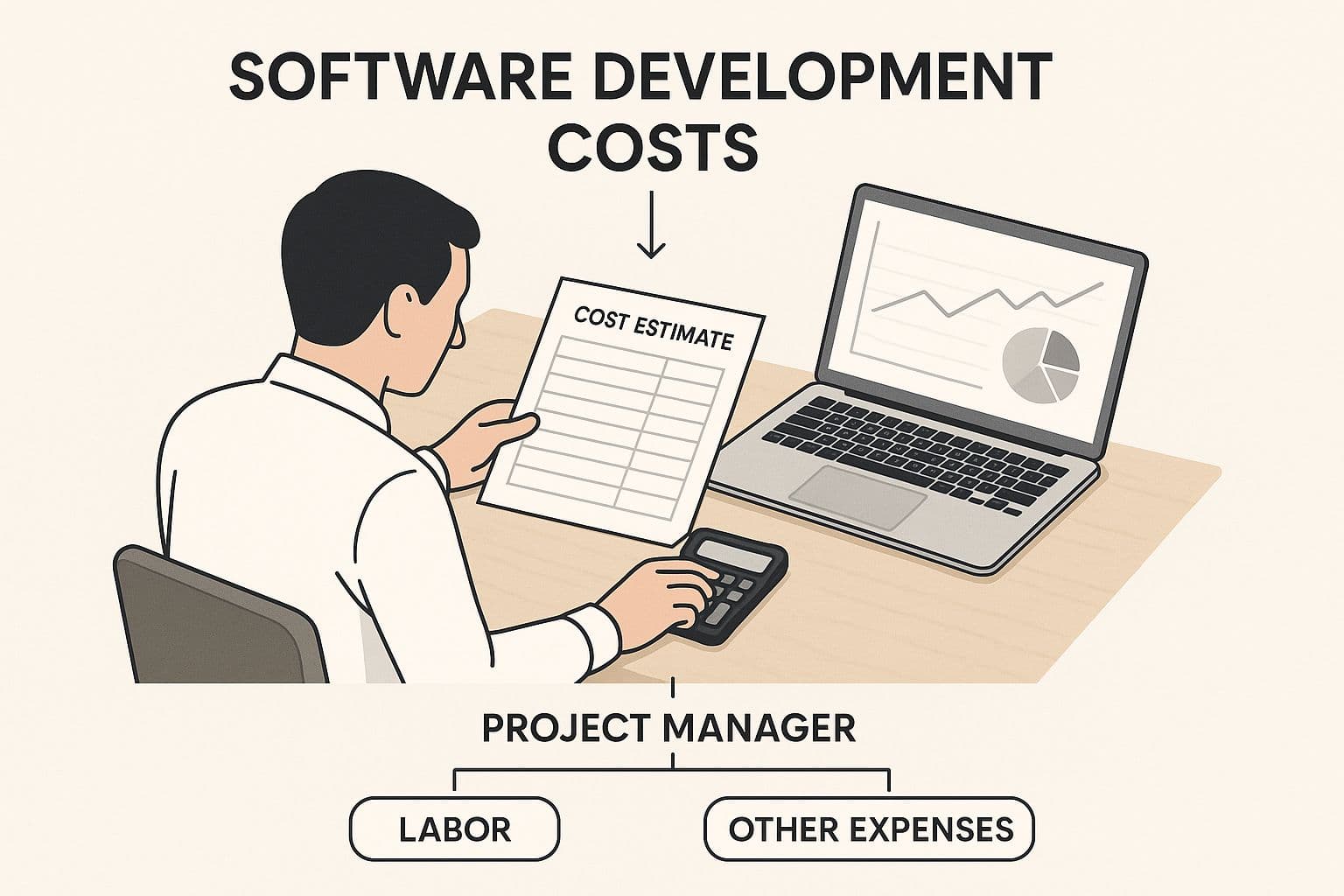Cost management for IT projects means planning, estimating, budgeting, and controlling costs so teams deliver value without exceeding the approved budget. This guide outlines practical steps, tools, and metrics to improve forecasts, reduce risk, and keep projects on track from kickoff to close.
October 8, 2025 (2mo ago) — last updated October 29, 2025 (1mo ago)
IT Project Cost Management: Plan, Budget, Control
Proven strategies and tools to plan, estimate, budget, and control IT project costs, improve forecasts, manage risk, and keep projects on budget.
← Back to blog
IT Project Cost Management: Plan, Budget, Control
Summary: Practical strategies to plan, estimate, budget, and control IT project costs—improve forecasts, manage risk, and keep projects on budget.
Introduction
Cost management for IT projects means planning, estimating, budgeting, and controlling costs so teams deliver value without exceeding the approved budget. This guide outlines practical steps, tools, and metrics to improve forecasts, reduce risk, and keep projects on track from kickoff to close.
Cost management covers the financial work from early planning and estimating through budgeting and ongoing cost control. The goal is straightforward: finish the project within the approved budget while maximizing value. It’s not just tracking expenses; it’s a forward-looking practice that makes each dollar count.
Why cost management keeps projects alive
Large IT projects often encounter major cost surprises. Industry research finds frequent and significant overruns, so proactive cost management is essential to avoid stalled work, funding shortfalls, and loss of stakeholder trust1.
Think of your budget as a ship’s provisions. You need a chart (your plan), contingency for storms (risk reserves), and regular checks on supplies so you don’t get stranded. Cost management is planning the route, navigating choppy waters, and adjusting when the unexpected happens.
The real cost of poor planning
When financial controls are an afterthought, the results are costly. Weak planning and loose estimation cause delays, scope creep, and funding shortfalls—each of which increases total cost and damages credibility.
Core concepts you need to master
Cost management centers on four activities:
- Planning: Define rules, policies, and procedures for how money will be managed.
- Estimating: Produce reliable approximations of task and resource costs.
- Budgeting: Roll up estimates into a time-phased cost baseline.
- Controlling: Monitor costs, manage baseline changes, and keep financial performance on track.
The aim isn’t just to spend less, it’s to spend smarter: allocate funds where they create the most value and get ahead of financial risks before they become project threats.
Build a financial blueprint step by step
Effective cost management is a living process. Like building a house, you need a plan, a budget, and controls to keep everything aligned. Your financial blueprint relies on four pillars that guide you from concept to completion.

A reliable forecast is built from data, the right tools, and clear analysis.
Cost planning: the strategic foundation
Cost planning sets the ground rules for how you’ll manage money. Decide units of measure (man-hours, story points), required estimate precision, and control thresholds that trigger review. This creates the process you’ll use throughout the lifecycle.
Cost estimating: forecast with accuracy
Estimating assigns costs to tasks, resources, and equipment. Estimates start broad and get more precise as scope becomes clearer.
Key activities:
- Resource costing: What will people, materials, and equipment cost?
- Risk reserves: Contingency funds for likely “what if” scenarios.
- Vendor bids: Real quotes from suppliers.
Underestimating risks running out of cash; overestimating can block approvals. Use structured techniques and business-focused tools such as the Business Valuation Estimator to justify investment decisions.
Cost budgeting: create your baseline
Budgeting aggregates estimates into an authorized, time-phased cost baseline. The baseline shows what money is allocated where and when.
The baseline is your financial yardstick. Every performance metric, variance, and change request is measured against it. Without it, you’re flying blind.
Cost control: stay on course
Cost control is the ongoing work once the project is active. Monitor spending, analyze variances between actuals and the baseline, and act quickly to correct course. Ensure scope changes are properly documented and funded.
Cost management processes at a glance
| Process | Objective | Key Output |
|---|---|---|
| Cost Planning | Define policies and procedures for managing project costs. | Cost Management Plan |
| Cost Estimating | Approximate financial resources needed. | Activity Cost Estimates |
| Cost Budgeting | Aggregate estimates to establish an authorized cost baseline. | Cost Baseline |
| Cost Control | Monitor status and manage changes to the cost baseline. | Work Performance Information |
Each stage builds on the last, turning financial management from a reactive chore into a proactive strategy.
Choosing the right cost estimation techniques
A solid budget starts with solid estimates. Replace guesswork with structured methods.
Common estimation techniques
- Analogous estimating: Use a similar past project as a starting point—fast and useful with good historical data.
- Parametric estimating: Scale a known unit cost, for example cost per function or hour. Accurate when data is reliable.
Both techniques are valuable but can underrepresent uncertainty.
Three-point estimating to reflect uncertainty
Three-point estimating maps a range of outcomes:
- Optimistic (O): Best-case scenario.
- Pessimistic (P): Worst-case scenario.
- Most Likely (M): The realistic outcome.
Calculate a weighted expected value and variance instead of a single number. Use a spreadsheet or estimator to make this practical. If you need to show ROI, try the Business Valuation Estimator.
Software and modern estimation tools
Project management and specialized tools raise estimate quality. Quality software helps maintain credible budgets and gives early warning when trends change. For event or campaign budgets, use the Event Planning Budget Allocator to distribute funds effectively.
Track and control costs like a pro
Once the project is running, move from planning to active financial steering. Cost control is about monitoring financial health and catching problems early.
Earned Value Management (EVM) is a proven method that answers three questions: Where did we plan to be? Where are we now? How much have we spent to get here? EVM gives clear, data-driven insight into progress and cost performance. Organizations that apply EVM and structured controls see better visibility into project health2.
Core EVM metrics
You only need three numbers:
- Planned Value (PV): Budget for the work planned by now.
- Actual Cost (AC): What you’ve spent.
- Earned Value (EV): Value of work completed measured against the total budget.
Example: halfway through a $40,000 project, PV = $20,000. If AC = $25,000 and EV = $16,000, you’ve spent more and achieved less than planned.
Cost Performance Index (CPI)
CPI = EV / AC. In the example, CPI = $16,000 / $25,000 = 0.64. A CPI below 1.0 is a red flag; above 1.0 is favorable. Track CPI regularly (weekly or bi-weekly) so you can intervene before variances grow.
Control cloud costs proactively
Cloud’s pay-as-you-go model can create large bills without careful controls. Implement cloud cost optimization practices and monitor usage closely so you pay only for what you need. For related guidance, see our post on Cloud Cost Optimization.
Adapting cost management for Agile and Waterfall
Match your cost management approach to the project methodology.
Waterfall: predictability and upfront control
Waterfall relies on heavy upfront planning and a locked cost baseline—best when requirements are stable.
- Fixed scope
- Detailed upfront budgeting
- Formal change control
Agile: fund outcomes, embrace change
Agile expects evolving requirements. Instead of fixing scope, fix budget and timeline and maximize delivered value.
- Fund teams for fixed periods
- Prioritize features by value
- Use story points and burn-up charts to show value delivered against budget
Both approaches work—choose the style that fits your project.
| Feature | Waterfall Cost Management | Agile Cost Management |
|---|---|---|
| Primary Constraint | Scope fixed; budget/time estimated. | Budget/time fixed; scope flexible. |
| Budgeting Style | Detailed upfront budgeting. | Incremental funding per release. |
| Tracking Focus | Variance from baseline. | Value delivered within budget. |
| Best For | Stable, well-defined requirements. | Evolving requirements and feedback-driven work. |
Action plan: make cost management practical
Turn theory into practice with a concise plan.
Establish a financial rhythm
- Share regular budget-health updates with stakeholders (weekly or bi-weekly).
- Implement a simple change control process that documents cost impact and requires formal sign-off before new work begins.
Integrate simple, powerful tools
- Use structured estimating like three-point estimating and include risk reserves.
- Track CPI and other EVM metrics regularly so you can act early on negative trends.
- Use focused estimators such as the Event Planning Budget Allocator and the Business Valuation Estimator where appropriate.
Proactive cost management is a learnable skill. It turns budget stress into a strategic advantage and helps you deliver value consistently.
Frequently Asked Questions
What are the most common reasons IT projects go over budget?
Scope creep, optimistic estimates, and weak risk management are the top causes. Small unfunded changes, optimistic estimates, and lack of contingency quickly erode budgets.
How can I convince stakeholders to invest in cost management tools?
Frame tools as value protectors. Show how early detection of issues turns a large problem into a small, fixable one. Demonstrations and short pilots can build confidence.
What is the first step to improve cost management?
Start measuring. The Cost Performance Index (CPI) is a strong first metric—simple, actionable, and revealing. Commit to updating CPI regularly and make it the foundation of your financial rhythm.
Quick Q&A
Q: How quickly should I set up cost controls on a new IT project?
A: Put basic controls in place before work begins: a cost baseline, regular reporting cadence, and a simple change-control process. That setup helps you catch issues early.
Q: Which estimating technique gives the best balance of speed and accuracy?
A: Start with analogous or parametric estimating for speed, then apply three-point estimating to reflect uncertainty and refine as scope becomes clearer.
Q: Is Earned Value Management worth implementing for mid-size projects?
A: Yes. Even simple EV calculations (PV, AC, EV) and CPI tracking give actionable insights that beat ad-hoc status reports.
Ready to Build Your Own Tools for Free?
Join hundreds of businesses already using custom estimation tools to increase profits and win more clients